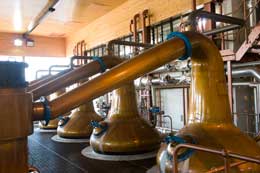I’m a very curious person. In fact, ever since I was a kid, this was one of the most commonly used adjectives to describe me. So naturally, I love comparisons. In particular, stills fascinate me, and I want to share some of that awe, so what could be more fun than asking about the “est” factor in stills?
We know that the process of distillation is pretty much the same until the wash comes out of the mash tun and goes into the washbacks. At that point, we get some divergence, as wasback materials and fermentation times vary from distillery to distillery. But the real fun starts in the stills, where the shape and the rate of distillation make HUGE differences in the character of the spirit.
I’m not a scientist, and the utterly incredible Whisky Science blog has those details in a more coherent way than I could ever get them in this very non technical blog, so I’d recommend reading a post on pot still distillation on there. But in short, the size, shape and specific process used in the still is of paramount importance to the whisky you get in the end. Fermentation creates, besides alcohol, also esters, acetone, fatty acids and sulfur compounds, each of which boils at a different temperature. Copper interacts with the alcohol vapor to clean and purify from sulfur, some of the esters and other (taste and scent imparting) impurities – called congeners, and together with the cut of the spirit (corresponding to the different boiling points of the wash or low wines components), the master distiller has control over the character of the new make.
In general, the more copper contact the spirit has during distillation and the harder it is for the vapors to escape the still, the purer, gentler, more floral and delicate the whisky you get. The shorter the time in the still, the more full bodied and harsher is the new make.
There are three types of stills:
- Onion stills are shaped like an onion and get little reflux and the least amount of copper contact (such are the stills at Macallan, Lagavulin, Ardmore and Bunnahabhain).
- Reflux bulge stills have a ball between the pot and the neck, causing some of the distillate to be redirected into the pot before it gets to the neck (like Glenfarclas, Old Pulteney, Knockdhu, Glenmorangie, Glen Grant and half the stills at Glenfiddich).
- Lantern stills have a narrow waist between the neck and the pot, constricting the passage of the vapors (e.g. Glenlivet, Glenkinchie, half the stills at Glenfiddich, Isle of Jura and Laphroaig)
At last, there is the lyne arm angle, which can contribute to refulx by being angled up.
Thus, a distiller desiring a light floral and fruity whisky, would use a tall still with a smaller volume output, a narrow passage between pot and reflux bulge and an lyne arm that would create reflux, looking like this:

Glenmorangie Stills
Whereas to make an oily, full bodied whisky, with strong flavors, you’d want stills looking like this:

Macallan Stills
So this post has three whiskies going head to head based upon the still shape and process: Tallest stills (Glenmorangie), shortest stills (Macallan) and slowest stills (Glengoyne). The Glengoyne stills, by the way, are in between the Glenmorangie and Macallan stills in terms of height and are less “agressively refluxed” compared to Glenmorangie. I’ve chosen the basic expression from each distillery, the Glenmarangie Original and Glengoyne 10, and the Macallan Fine Oak 12. I do have the Fine Oak 10 available to me, but I’ve chosen to go with the 12 because it’s the expression still available in stores.
Glengoyne 10 (40% ABV, uncolored)

Glengoyne stills
Color: Straw, legs relatively slow and spaced out.
Nose: Fresh summer fruit (peaches, apricots and plums), fresh green grass, after a while you get a faint green apple (the bottle has it on the “official tasting notes”, but it’s nowhere near as pronounced as the green apple in Glenfiddich 12, for example). Some floral notes as well, with a slight similarity to the Glenmorangie. After a while, or in a second dram, the Oloroso sherry notes are more noticeable.
Palate: Malt, lemon, spice (specifically pepper), soft and silky mouth feel.
Linger: Long and very peppery. Also malt notes, mainly on the back of the throat.
Glenmorangie Original (40% ABV)
Color: Gold, fast legs.
Nose: A bouquet of spring flowers with undertones of vanilla and faint citurs with spices and toffee in the background. Very delicate and prefume like.
Palate: Soft and gentle with malt and spice, vanilla and toffee. Very easy on the palate.
Linger: Short and delicate, with spice (pepper and cinnamon) flashing through.
Macallan Fine Oak 12 (40% ABV, nonchill filtered and uncolored)
Color: Light gold, slow legs.
Nose: Vanilla and lemon are very dominant. Aromas are strong. Under the vanilla and lemon are raisins and spices with oak wood
Palate: Strong and present, very creamy, almost even oily. Flavors of lemon, vanilla and fresh fruit with pepper and some
Linger: Medium and sweet (ish) at the back of the throat. Raisins and wood, vanilla – obvious bourbon and sherry cask influence.
In summation, still shape and distillation process have a profound effect on the spirit, and are another, less discussed aspect of our whisky exploration. When I experience a new whisky, I always try to find a picture of the stills, and see if I can relate what I nose and taste to the still. Sometimes it’s obvious, and sometimes less – but always fascinating!


5 comments on “The “est” Factor in Whisky Stills: Tallest, Shortest and Slowest”